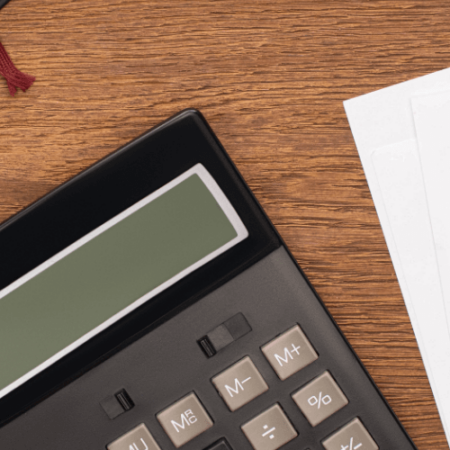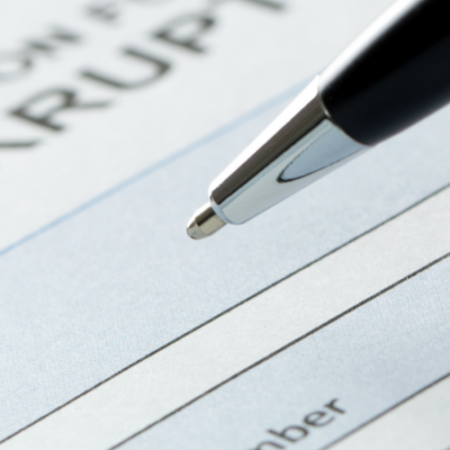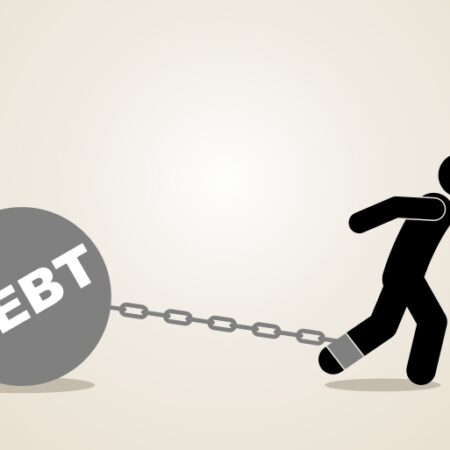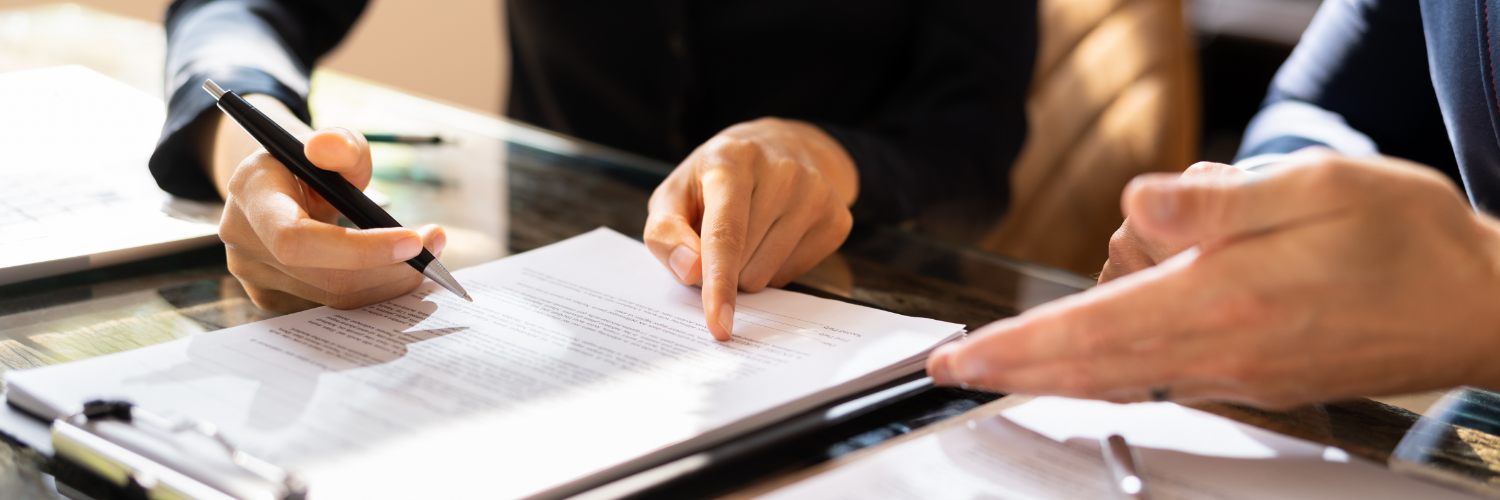
Disclosure regarding our editorial content standards.
Personal bankruptcies rates have remained historically low in the past few years. Read on to find out bankruptcy rates by state, what you should do if you’re facing bankruptcy and how to maintain good credit.
How to understand bankruptcy rates
When discussing bankruptcy, it’s important to know that there are several main types of personal bankruptcies.
Chapter 7: Requires asset liquidation and is mostly used by individuals who don’t have sufficient funds to pay off their debt. It offers the complete elimination of certain types of existing debt.
Chapter 13: Reserved for individuals with a regular income. It stipulates a debt repayment plan not to exceed five years.
The simplest way to understand bankruptcy rates is that they represent the number of people who—for whatever reason—were unable to pay their debt and sought relief. Most filers choose either Chapter 7 or Chapter 13, depending on their personal circumstances.
Chapter 7 allows for the discharge of certain types of debt without repayment but may result in asset forfeiture. Conversely, Chapter 13 requires a payment plan and in exchange, filers can typically retain ownership of certain assets, such as their home.
What does the bankruptcy landscape look like in 2022?
After rising steadily from the 1980s to the early 2000s, bankruptcy rates hit a new record in 2005 at over 2 million cases. Since then, the numbers have largely declined, and in 2021, fewer than half a million bankruptcies were filed. This downward trend has continued through early 2022, with bankruptcy rates remaining lower than in previous years.
However, bankruptcy rates are starting to inch back up after historic declines. With pandemic-related aid receding and inflation rising, households are feeling the squeeze, and bankruptcy rates are expected to continue to rise throughout 2022.
Bankruptcy rates by state
These are the bankruptcy rates by state for 2021, according to the American Bankruptcy Institute. In 2021, there were a total of 397,069 bankruptcies filed. *Cases included in totals reference commercial business as part of bankruptcy petition filing.
| State | Cumulative 2021 Filings | Chapter 7 Ratio | Chapter 13 Ratio |
| Alabama | 14,716 | 39% | 61% |
| Alaska | 214 | 86% | 12% |
| Arizona | 9,353 | 85% | 14% |
| Arkansas | 5,256 | 52% | 47% |
| California | 39,505 | 86% | 13% |
| Colorado | 6,281 | 80% | 19% |
| Connecticut | 2,947 | 86% | 13% |
| Delaware | 1,623 | 48% | 18% |
| Florida | 30,685 | 72% | 27% |
| Georgia | 20,830 | 47% | 52% |
| Hawaii | 1,187 | 72% | 28% |
| Idaho | 1,930 | 90% | 9% |
| Illinois | 20,343 | 70% | 29% |
| Indiana | 13,962 | 69% | 30% |
| Iowa | 2,765 | 89% | 10% |
| Kansas | 3,445 | 57% | 42% |
| Kentucky | 8,647 | 65% | 35% |
| Louisiana | 5,790 | 37% | 62% |
| Maine | 629 | 86% | 12% |
| Maryland | 8,078 | 73% | 26% |
| Massachusetts | 3,368 | 71% | 27% |
| Michigan | 16,056 | 78% | 21% |
| Minnesota | 5,645 | 82% | 17% |
| Mississippi | 5,997 | 56% | 43% |
| Missouri | 9,527 | 65% | 35% |
| Montana | 613 | 85% | 14% |
| Nebraska | 2,522 | 74% | 25% |
| Nevada | 6,802 | 89% | 10% |
| New Hampshire | 729 | 81% | 18% |
| New Jersey | 9,977 | 73% | 25% |
| New Mexico | 1,400 | 89% | 10% |
| New York | 14,292 | 85% | 12% |
| North Carolina | 6,409 | 45% | 53% |
| North Dakota | 521 | 91% | 8% |
| Ohio | 20,306 | 80% | 19% |
| Oklahoma | 5,731 | 88% | 12% |
| Oregon | 4,550 | 82% | 18% |
| Pennsylvania | 10,122 | 67% | 32% |
| Rhode Island | 937 | 83% | 16% |
| South Carolina | 3,339 | 47% | 52% |
| South Dakota | 590 | 88% | 10% |
| Tennessee | 15,122 | 49% | 50% |
| Texas | 19,308 | 63% | 32% |
| Utah | 5,473 | 66% | 34% |
| Vermont | 271 | 82% | 16% |
| Virginia | 12,245 | 66% | 33% |
| Washington | 5,797 | 81% | 18% |
| West Virginia | 1,611 | 88% | 11% |
| Wisconsin | 9,094 | 72% | 27% |
| Wyoming | 529 | 91% | 6% |
The first thing to consider when you’re facing bankruptcy is to consider alternative steps you can take to avoid filing for bankruptcy if you’re struggling to pay your debt.
Things to consider if you are facing bankruptcy
1. Debt settlement
A debt settlement is an agreement you make with your creditors to reduce the balance owed and pay a lump sum as opposed to monthly installments. This is an alternative to bankruptcy that is generally reserved for unsecured debts, such as credit cards and medical bills. Generally, secured debts are ineligible for settlement.
Debt settlement often facilitated by a for-profit company that charges a fee on the original debt amount and then serves as an intermediary between you and the original creditor by collecting payment and holding the money in escrow. The debt settlement company negotiates on your behalf to secure more favorable repayment terms and conditions.
2. Debt consolidation
Debt consolidation is the process of combining multiple debts into one and refinancing at a lower interest rate. This type of refinancing works for high-interest unsecured debts, such as credit cards. You can effectively achieve debt consolidation by either taking out another loan to cover your debt or by borrowing against other assets, such as your home or your 401(k).
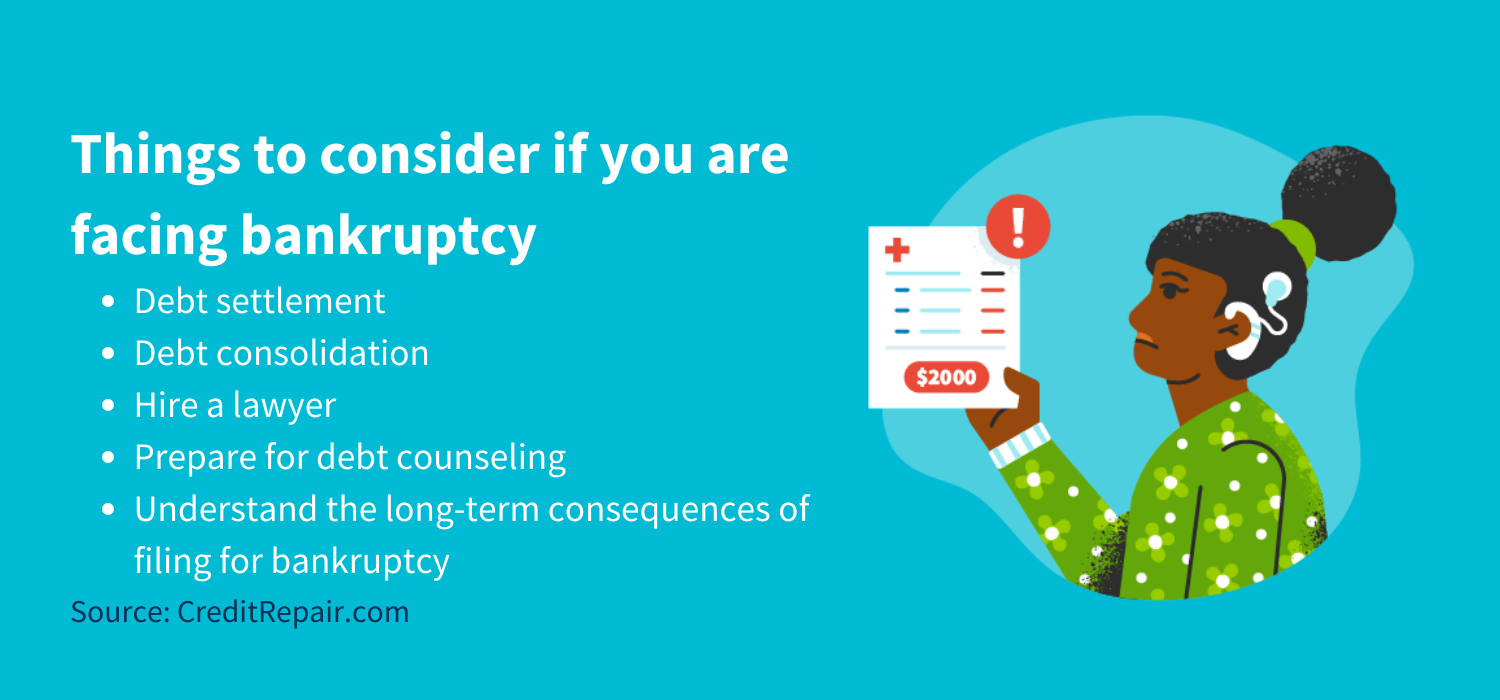
3. Hire a lawyer
A lawyer is one expense you don’t want to spare when facing bankruptcy. A bankruptcy lawyer can guide you through the process of filing for bankruptcy and help you understand what to expect. They’ll gather information about your financial situation and represent you at any hearings related to your case.
4. Prepare for credit counseling
Before you can file for most bankruptcies, you’ll need to attend credit counseling, which is required by the U.S. Department of Justice. In this session, a certified credit counselor will “review your income and expenses, discuss alternatives and help you develop a personal budget.” (Debt.com)
Credit counselors also evaluate your ability to repay your debt and confirm your need to file for bankruptcy. The Department of Justice maintains a database of approved credit counseling agencies for individuals pursuing bankruptcy.
5. Understand the long-term consequences of filing for bankruptcy
While bankruptcy is almost never desirable, it’s not all bad news. Bankruptcy can provide a viable path out of overwhelming debt and offer relief from debt collectors’ persistent communication.
However, be aware that filing for bankruptcy doesn’t necessarily mean an automatic blank slate, and you may see negative impacts on your life and finances long after you file. These may include:
- Difficulty renting an apartment or getting hired for a job
- Your bankruptcy proceedings are public records and discoverable by anyone
- Your credit will be adversely impacted for up to 10 years
How to work on your credit
No matter if you are considering bankruptcy or not, never forget that your credit can benefit from good money habits and staying in control of your finances. Here are a few helpful tips for working on your credit.
1. Set up automatic payments
Paying your bills on time is one of the oldest and most helpful tricks in the book for keeping your credit healthy. By turning on automatic payments, you can be sure you won’t miss a payment and get hit with a late fee, which can hurt both your bank account and your credit score. Some companies even offer you a discount for using automatic payments.
2. Become an authorized user on another account
You can benefit from a friend or family member’s healthy financial practices by becoming an authorized user on their account. The basis of this method is that your credit gets a boost by them simply keeping on top of their bills while you’re connected to their account. Make sure the person you choose has a strong credit history and that they report you to the credit bureaus as an authorized user. Who can be added varies by creditor, so this isn’t an option for everyone.
3. Leave old accounts open
Even if you’re no longer using a credit card, it may still make sense to keep the account open. Doing so could help bolster your credit score by increasing the amount of credit you have available and decreasing your credit utilization ratio. Generally speaking, the longer an account is open in good standing, the more it helps your overall credit history.
As bankruptcy rates rise, you can avoid becoming another statistic by developing effective ways to manage debt or stay out of it entirely. Cultivate positive financial habits and consider working with CreditRepair.com to use their experience to help get your credit back on track.
The first thing to consider when you’re facing bankruptcy is to consider alternative steps you can take to avoid filing for bankruptcy if you’re struggling to pay your debt.
Note: The information provided on CreditRepair.com does not, and is not intended to, act as legal, financial or credit advice; instead, it is for general informational purposes only.
Questions about credit repair?
Chat with an expert: 1-800-255-0263




